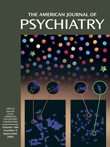The World Trade Center disaster was an event of unprecedented magnitude and impact in U.S. history, in loss of human life and threat to national assumptions regarding safety and prosperity. Dissociative symptoms in the acute aftermath of trauma (peritraumatic dissociation) may be an indicator of more disabling and persistent subsequent pathology
(1). Six months after a disaster bearing many similarities to the World Trade Center attack (the Oklahoma City bombing), intrusive and hyperarousal symptoms were found to be nearly universal in survivors and not associated with other psychopathology or impairment, whereas dissociation and avoidance were highly associated with comorbidity, impairment, and need for treatment
(2). The onset of posttraumatic stress disorder (PTSD) was acute, with 76% of affected individuals experiencing onset on the first day. Similar findings were reported for earthquake survivors 3 months after the disaster (3); reexperiencing and arousal were common and seemingly normal, whereas avoidance and numbing were rarer and associated with psychiatric morbidity. Magnitude of exposure to disaster also affected psychiatric outcome
(2,
4).
We predicted that marked distress and early trauma-related symptoms would occur, even in individuals with lesser degrees of exposure to the World Trade Center disaster, given its unprecedented magnitude and its uniformly perceived danger and malice. We were also interested in investigating the relationship between components of subjective distress and the development of early dissociative and posttraumatic stress symptoms.
Method
We developed a brief questionnaire of early reactions to the World Trade Center disaster. The study was approved by our institutional review board with waiver of written informed consent. There was no agency funding for this early preliminary study, and two advertisements were placed in a local newspaper targeting adults “significantly affected” by the disaster. This free weekly newspaper claims a circulation of about 254,000 and is distributed widely among the five boroughs of New York City. The readership has a median age of 35; 42% of the readers are female, 57% are college graduates, 56% are in professional or managerial occupations, and ethnic distributions are white=38%, black=36%, Hispanic=20%, and Asian=6%. Responders to advertisements were sent the survey with a return envelope and offered a $10 compensation fee, and data collection was completed within 3 months of the disaster.
The survey included a face page summarizing the study’s purpose and approval by our institutional review board, demographic information, yes/no questions regarding exposure, and three scales applied to the period “during and shortly after the disaster.” Such uniform inquiry allowed us to measure symptoms during a comparable early posttraumatic phase, thus avoiding the dichotomy of assuming that dissociation occurs peritraumatically and PTSD occurs 1 month later.
Yes/no questions regarding specific types of exposure to the disaster were asked (
Table 1). A scaled score of 1 to 10 to quantify magnitude was then applied to “yes” answers, anchored as “saw jet crash or tower collapse on television”=1 and “was in tower”=10. Independent ratings of magnitude were first assigned to each exposure by each of three investigators (D.S., J.G., and M.K.), with an average intercorrelation coefficient of 0.88. A consensus rating was then reached for each exposure, approximating the average of the three independent ratings, with the exception of certain items with weaker agreement for which a consensus clinical agreement was first attained.
The Peritraumatic Distress Inventory
(5) is a 13-item self-report measure of distress during and immediately after a trauma, scored from 0 (not at all) to 4 (extremely true). It is internally consistent (coefficient alpha=0.74), with good test-retest reliability (correlation coefficient=0.74) and good convergent and divergent validity against various measures. A factor analysis of the Peritraumatic Distress Inventory was conducted on our study group in order to explore whether different aspects of distress may be predictive of different psychopathological symptoms. Varimax rotation generated a four-factor solution consisting of all factors with eigenvalues greater than 1, together accounting for 66.1% of the total variance (33.4%, 14.9%, 10.1%, and 7.7%, respectively). The items were required to have loadings of at least 0.50 on a particular factor (in effect, most loadings were much higher) and to differ by at least 0.10 from their next highest loading to be assigned to a particular grouping, leading to the exclusion of item 11. The remaining items were grouped into four distress factors: life threat (item sum=2, 4, 7, 10, and 13), loss of control (item sum=8, 9, and 12), helplessness/anger (item sum=1 and 3), and guilt/shame (item sum=5 and 6).
The Peritraumatic Dissociative Experiences Questionnaire
(1) is a widely used, reliable (Cronbach’s alpha=0.80), and valid questionnaire that assesses retrospective reports of dissociation during trauma. We employed a self-rated version of the original eight-item questionnaire with similar wording and the same score range as the original: not at all true=1, somewhat true=2, and definitely true=3.
The Impact of Event Scale—Revised
(6) is a widely used self-report measure of PTSD that can be applied to a single trauma. An expanded set of 22 items, rated from 0 (not at all) to 4 (extremely), yields reexperiencing, avoidance, and arousal scores. For all three scales, the total score was the sum of all item scores.
Subsequently, five stepwise multiple regression analyses were performed to determine the strongest predictors of dissociation by distress factors, as well as the strongest predictors of posttraumatic stress by distress factors and dissociation. Since severity of exposure is a well-accepted predictor of symptoms, we removed the variance explained by exposure by covarying scaled exposure magnitude by means of forced first-block entry. The remaining four or five predictors were then entered stepwise into a second block. In order to correct statistically for the number of predictor variables in the second block, an adaptation of the Scheffé procedure for multiple comparisons was used in which the sum of squares for each predictor in the stepwise analysis was tested with the degrees of freedom for all of the predictors in the second block.
Results
Of 96 individuals who requested the survey, 78 returned it completed (81.3%). Three subjects were eliminated because of missing data, leaving 43 women and 32 men in the final group, with a mean age of 40.3 (SD=12.3, range=21–68). Ethnicities were as follows: 53% white, 28% African American, 10% Hispanic, 4% Asian, 1% Native American, and 4% mixed. The highest level of education included completed/partial high school (13%), completed/partial 2-year college (19%), completed/partial 4-year college (49%), and completed/partial graduate degree (19%). Employment status included student (5%), homemaker (4%), retired (3%), and unemployed (5%); and 83% were employed in an extensive range of professions (e.g., banking, administration, couriering, teaching, law, and manual labor).
The mean scaled exposure score was 44.7 (SD=26.4), ranging from 1 (three individuals who had only witnessed the event on television) to 121 (
Table 1). Mean scores on the Peritraumatic Distress Inventory, Peritraumatic Dissociative Experiences Questionnaire, and Impact of Event Scale—Revised were 35.2 (SD=6.9), 15.0 (SD=2.9), and 48.1 (SD=18.2), respectively. Internal consistency, as measured by coefficient alpha, was 0.82, 0.65, and 0.92, respectively, for the three scales. Mean PTSD subscale scores were 20.4 (SD=7.6) for intrusions, 13.6 (SD 7.5) for avoidance, and 14.1 (SD=6.3) for arousal. The total scaled score for exposure magnitude significantly correlated with total distress (r=0.39, df=73, p<0.01), dissociation (r=0.24, df=73, p<0.05), and posttraumatic stress (r=0.49, df=73, p<0.01). Dissociation score, posttraumatic stress total and subscale scores, and distress total and factor scores had intercorrelations ranging from 0.12 to 0.63.
After we covaried for exposure magnitude (R2=0.06, F=4.54, df=1, 73, p<0.05), dissociation was best predicted by the loss of control distress factor (beta=0.52, corrected F=6.70, df=4, 69, p<0.001). No other variables significantly contributed to the prediction. After we covaried exposure magnitude (R2=0.24, F=22.59, df=1, 73, p<0.001), posttraumatic stress was best predicted by loss of control (beta=0.53, corrected F=8.44, df=5, 68, p<0.001), with additional contribution from helplessness/anger (beta=0.35, corrected F=3.46, df=5, 68, p<0.01). Dissociation did not additionally contribute to the prediction of posttraumatic stress.
Different patterns emerged for each of the three PTSD clusters. Reexperiencing, after covariance for exposure (R2=0.23, F=21.68, df=1, 73, p<0.001), was best predicted by dissociation (beta=0.48, corrected F=6.89, df=5, 68, p<0.001), with additional contribution from helplessness/anger (beta=0.30, corrected F=4.43, df=5, 68, p<0.01). Avoidance, after covariance for exposure (R2=0.11, F=8.88, df=1, 73, p<0.01), was best predicted by loss of control (beta=0.45, corrected F=3.98, df=5, 68, p<0.01). Arousal, after covariance for exposure (R2=0.19, F=17.24, df=1, 73, p<0.001), was best predicted by life threat (beta=0.41, corrected F=3.94, df=5, 68, p<0.01). Other variables did not make an additional significant contribution to the prediction of avoidance or arousal.
Discussion
As hypothesized, this pilot survey study of reactions occurring in the acute aftermath of the World Trade Center disaster revealed high levels of subjective distress and early dissociative and posttraumatic stress symptoms, even within a group of individuals who were not all maximally affected and whose personal involvement varied greatly. These findings then reflected the extremely powerful effect of this profoundly disturbing event, possibly widely characteristic of the New York City community. As a descriptive comparison, the original Peritraumatic Dissociative Experiences Questionnaire study
(1) found a 25% lower total dissociation score of 11.3% in Vietnam-theater veterans. The original Peritraumatic Distress Inventory study
(5) reported a 57% lower total distress score of 15.1% in police officers rating their most troublesome exposure.
We examined the predictive power of components of the initial subjective distress experience with respect to early trauma-spectrum symptoms. Of interest, loss of control (losing control of emotions, difficulty controlling bowels and bladder, fainting) was the most powerful predictor of both early dissociative and early posttraumatic stress symptoms
(7). Despite an extensive literature suggesting that peritraumatic dissociation may be strongly predictive of later PTSD
(1), in this group, it did not add to distress in predicting early PTSD, with the exception of reexperiencing. This latter finding may suggest that disturbing material that is strongly dissociated does not have the opportunity to be emotionally processed and therefore continues to intrude on awareness
(8). Fears for one’s own and others’ safety and the threat of death did not predict early dissociative and posttraumatic stress symptoms as powerfully as we had expected, but they did predict arousal, in particular. Finally, the distress factor of guilt and shame did not contribute to any symptom predictions; such feelings probably play a greater role in certain interpersonal traumas.
The survey suggests that application of this brief, straightforward method of assessing peritraumatic reactions could be fruitful in upcoming studies of the impact of the World Trade Center disaster. Our pilot study was limited by its small size and its survey nature. Various sampling biases in all likelihood affected which individuals chose to respond to the survey—for example, more distraught individuals may have been more inclined to participate. Also, the demographic characteristics of our group may differ distinctly from those of the New York City community, although upon cursory examination, they do not appear markedly dissimilar from those of the general readership of the newspaper in which we advertised. Retrospective reporting is another shortcoming, although our survey was conducted within 3 months of the event. The use of a modified by self-report version of the original Peritraumatic Dissociative Experiences Questionnaire, with lower internal consistency than that reported in the original publication, is another limitation. The study’s strengths included its fairly proximal disaster data collection, good rates of response to the mailed surveys, and overall use of well-accepted measures.


